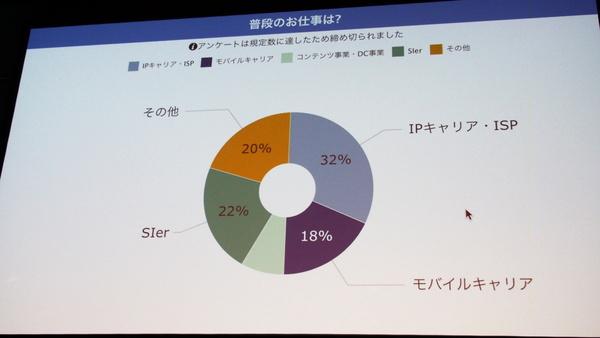ASCII.jp "What the future core netw...
05
01
ASCII.jp "What the future core network should be" Discussed by 4 manufacturers
On November 7, 2018, Toyo Technica's private conference "Core Router Summit in TOKYO 2018" was held.
"Core Router Summit in TOKYO 2018" held at the Tokyo International Forum. A panel discussion was held with four core router manufacturers on stage
At the end of the conference, a panel discussion titled "What the future core network should look like" was held by four core router manufacturers. Integrating various services into core networks using VNFs (Virtual Network Functions), and discussing future visions based on trends such as new technical standards such as 400 Gigabit Ethernet (400GbE) and Segment Routing (SR). bottom.
Mr. Hitoshi Uta, Assistant Professor, Ph.D. (Information Science), Information Society Research Center, Japan Advanced Institute of Science and Technology, who served as moderator, and four manufacturers (Juniper Networks, Huawei Japan, Cisco Systems, Nokia Solutions & Networks) )
What are the requirements for the future core network?
The session will begin with the attributes of visitors, their involvement with the core network, keywords of interest, and advanced technologies such as 400GbE and SR. It started with a real-time questionnaire on whether the
Attributes of visitors and how they relate to the core network. Many visitors were involved in the planning and design of carriers/ISPs and core networks.
Over 10% of 400GbE visitors and over 30% of SR visitors are already in operation/evaluation.
Next, panelists from four manufacturers analyzed market trends and introduced their own strategies, including a review of the lecture session held on the same day.
Masahiro Ueda of Juniper Networks said in a survey of service providers that 95% have plans to migrate services from physical routers to virtual routers/VNFs, and that customer enterprises are planning to migrate from on-premises to public cloud. After citing the fact that it is possible to use it in the future, he summarized the requirements for future core networks as "simple," "scale-out," and "open (programmable)."
"If it is not 'simple', it becomes complicated when adding a new service or scaling out, and it becomes unmanageable. 'Scale out' has been used as a PNF (in hardware) until now. Performance that could not be achieved without implementation can now be implemented with VNFs (in software), making it easier to scale out according to demand."Open" means programmability, combined with third parties and OSS We will provide frameworks that can be used to create visualizations and automation capabilities.” (Mr. Ueda)
Mr. Masahiro Ueda, General Manager, Technical Business Promotion Headquarters, Juniper Networks Technology Headquarters
Summary of future requirements for the core network
Huawei Japan's Masao Akada said that the core router elements that make up the core network at the company are "ultra broadband" with scalability that can increase capacity in the future, core networks with multiple domains, core / He defines it as "simplified," which integrates and cooperates with the operations of edge networks, IP/optical layers, etc., and "intelligent," which includes traffic prediction through AI/machine learning and accurate simulations when designing network paths.
Mr. Akada explained that SR also resets and "simplifies" the complicated protocol group in conventional MPLS. “In the mobile world, it will be reset at the timing of LTE to 5G, etc., but in the world of core networks, it is difficult to make drastic changes because the past drags on. My personal impression is that "reset") is needed somewhere" (Mr. Akada).

Huawei Japan Carrier Business Division CTO Masao Akada
Segment Routing protocol is taken as an example of simplification
Mr. Teppei Kamada of Cisco Systems, while citing the same requirements as Mr. Ueda and Mr. Akada for carrier core networks, said, "What kind of direction will we take to realize them?" talked about One approach is to stick to the ``clay pipe'', that is, to provide only the minimum required network functions in the core network and implement complex function groups with overlays, but that is ``not interesting for me personally. (Mr. Kamata). As another approach, he suggested that the core network should consider "providing more value than the 'clay pipe'".
"For example, SRv6 network programming. It is a technology that programs network functions into the packets themselves. If it is processed by an underlay router instead of an overlay, the core network will have more value than a 'clay pipe'. Also, IPv6. There is also the idea of ICN (Information Centric Network, Content Oriented Network) that gives meaning to addresses.Technology development is progressing to give network intelligence by giving programmability to packets themselves. There is no answer as to whether it should be done in the core network or not." (Mr. Kamata)
Mr. Teppei Kamata, System Engineering Headquarters, Service Provider Division, Cisco Systems
The question of whether the core network should only have the function of a “clay pipe”
Mr. Yasuo Kashimura of Nokia Solutions & Networks said that the future will require end-to-end management of not only core networks but also access networks and services. To achieve this, he says, Underlay's core network will first need to be more flexible, dynamic and intelligent.
"How can various functions and users that are flexibly arranged (on the network) be connected flexibly and quickly while maintaining the required service level? I think that is what is required of the core network. Borrowing the word 'dope,' it is not just a static 'dope,' but an image of a more dynamic, flexible, and intelligent 'dope,'" says Kashimura.
Nokia Solutions & Networks IP/Optical Networks IP Routing Division Manager Yasuo Kashimura
It is pointed out that the evolution of the core network side is also required for 5G mobile
To what extent should the functions of the core network be expanded?
In response to the four comments, moderator Mr. Uda said, "On the other hand, while 'simplification' is a requirement, how far can the core network function?" Do you think we should have
As the core router hardware technology continues to improve, Huawei Akada said, as mentioned above, the function groups such as multiple domains, core/edge, IP/optical, which have been provided by separate devices until now, have been integrated. point out that it is possible. This brings benefits such as simplification of operation, reduction in the number of devices, and reduction in power consumption.
Multi-domain integration example with core router introduced by Mr. Akada
Assuming an environment consisting of multiple vendors, Mr. Kashimura of Nokia believes that the core network should be able to provide "abstracted/unified information" that can be handled even if the orchestrator is from a different vendor. Mr. Ueda also said, "Intelligence should be placed on the service side, not on the core side," indicating that it is important for the core network to have the availability to meet such service requirements.
On the other hand, Mr. Cisco Kamata sympathized with the ideas presented by both of them, but said, "If it's just that, it's not interesting (lol)", and the processing that the core router can do is expanding "(Introduced in the session on the same day I hope that network programming with SRv6 will be one of the answers."
"The network classification of underlay/overlay has been used for a long time, but some of the functions that were realized in the overlay can now be integrated into the underlay. It seems that there will be no change. I would like to raise the question that the time is approaching to review the underlay/overlay division and architecture as well.” (Mr. Kamata)
In addition, while taking questions from the audience, discussions were held on themes such as "the security that core networks should have," "the role of software routers in improving performance," and "test automation," and the scheduled time was exceeded. The panel discussion concluded.








